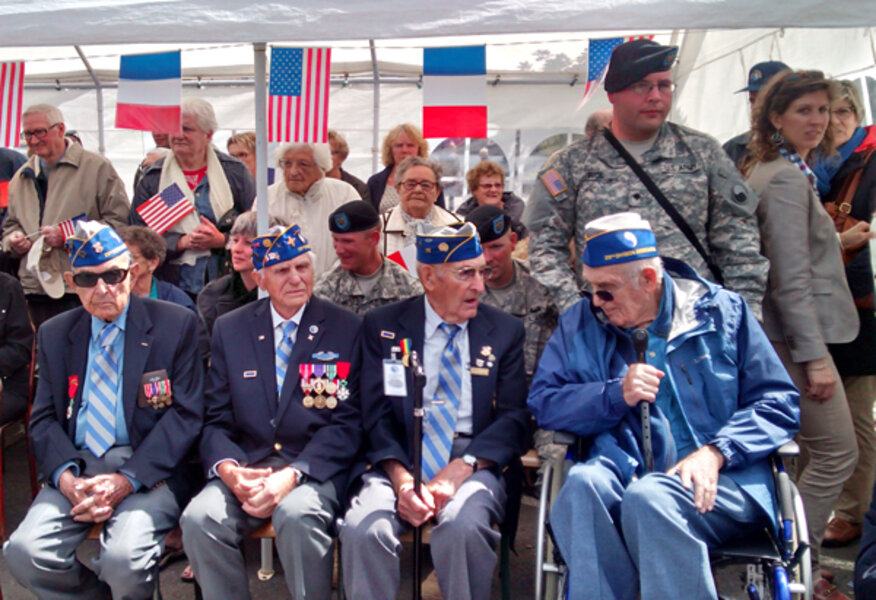'Hon, I’m not getting any younger': US vets return to Normandy 70 years later
| La Cambe, France
Allied veterans are gathering this week in the windswept villages of Normandy to commemorate a pivotal moment in the liberation of Europe from Nazi occupation. But on this 70th anniversary, as visitors join in a massive homage of American flag-waving and military flyovers, attention is keenly focused on how best to preserve the legacy of those who stormed the beaches in the largest seaborne invasion in history.
Of the 16 million Americans who served in World War II, only around 1 million veterans are still living. They are men like James Kunkle, a fighter pilot who at 91 says he’s the last living member of his squadron. Or couples like Edward and Jean Tierney, married since they met on the C47s on which they served, he as a pilot, she as a rescue nurse. The two have returned 18 times to Normandy – in sharp contrast to Joe Steimel, who finally decided in his ninth decade that he was ready to see the battlefield once again.
“I’d been pushing him to return when one day he said to me ‘Hon, I’m not getting any younger,’” his wife, Judy, says. “I had to keep a straight face.”
"As we lose this generation, it’s important that we look back to the past so that we don’t forget,” says Lt. Gen. Donald M. Campbell, Jr., the commanding general of US Army Europe. “It is as Tom Brokaw so aptly put it the greatest generation from many different nations that stormed these beaches.”
Eighteen national leaders are planning to join 3,000-some veterans this year to commemorate D-Day. The list includes President Obama, who will lay a wreath for the more than 9,000 Americans buried at a cemetery at Colleville-sur-Mer with French President François Hollande. Queen Elizabeth will attend the international ceremony, as will German Chancellor Angela Merkel and Russian President Vladimir Putin. The American Chamber of Commerce in France, along with others, organized a conference where CEOs, politicians, and academics will debate the legacy of the turning points of D-Day, when thousands of Allied troops caught the Germans off guard and changed the momentum of World War II. Both sides lost thousands of lives.
“D-day had a tremendous symbolic significance,” says war historian and author of “D-Day: The Battle for Normandy,” Antony Beevor. “It had an emotional patriotic significance far beyond what we can imagine today.”
Revisiting Normandy
That intensity plays out across Normandy in places like La Cambe. On a recent day, about a dozen veterans are being honored with a military band in the picturesque town, just 10 miles from the coast where the veterans landed. As they take front row seats in the town plaza, one hands out American flag pins to the townspeople. Small children wave American flags as they sing the Marseillaise, France’s national anthem. The mayor has just renamed the central plaza after the 29th US Infantry Division Blue and Gray, which liberated the town on June 8, 1944, two days after D-Day.
“It’s always an awesome sight,” says Mrs. Tierney, the rescue nurse, who says even after all of these visits, the outpouring of support is deeply moving. “There are a lot of feelings,” she says. “It’s part of your youth, and then there are so many young guys who were lost.”
“We love to come back, and see our French friends. We have a lot of memories, we love the food,” says Mr. Tierney. “And the girls,” says his wife, poking her 91-year-old husband.
“But we also think about the ones who landed on the beach and sacrificed their lives. It’s always two-sided,” Tierney adds.
Charlene Thereze, a hairdresser from La Cambe who brought her 8-year-old son to the town ceremony, knows this might be the last time that the townspeople physically stand with the veterans, but she says their memory must live on.
It surely will in museums, annual commemorations, and stories passed down among generations and between nations. Still, the loss of direct contact with the people who steered history has lent a certain poignancy over today’s events.
“You can feel it, this is one of the last ones that the veterans will be out en force,” says Marc Hope, a battleground guide who has traversed the main sites of World War II for 23 years. “Everyone knows it, it’s emotional.”
A grim day
Just a few steps away, John Cummer, an 89-year-old gunner’s mate who landed on Gold Beach around 10:20 a.m. on D-Day, recalls a “gray, rainy, busy, noisy, and kinda scary” day, as tourists, villagers, and military enthusiasts gather around him.
He says the night before he landed he needed quiet time, and found a place in his vessel to read Psalm 91, part of which he recites today. “A thousand may fall at your side, ten thousand at your right hand, but it will not come near you,” he says. “It gave me a sense of peace.”
“And we weren’t scratched,” he adds.
For men like Steimel, who served in the 29th after which the new town square in La Cambe is named, it's just plain hard to explain why it took him a lifetime to get back here.
“I’m so glad I got to meet these people,” says Steimel, who is from Indianapolis and was just 19 in 1944. But then he breaks down, talking about the confusion and blurry lines of the battlefield. “I couldn’t see anything. I want to say to the French, if I killed any civilians, I am truly sorry.”






